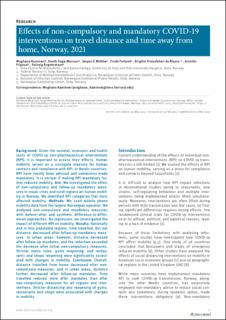| dc.contributor.author | Kamineni, Meghana | |
| dc.contributor.author | Engø-Monsen, Kenth | |
| dc.contributor.author | Midtbø, Jørgen E. | |
| dc.contributor.author | Forland, Frode | |
| dc.contributor.author | De Blasio, Birgitte Freiesleben | |
| dc.contributor.author | Frigessi, Arnoldo | |
| dc.contributor.author | Engebretsen, Solveig | |
| dc.date.accessioned | 2024-01-19T09:27:05Z | |
| dc.date.available | 2024-01-19T09:27:05Z | |
| dc.date.created | 2023-05-31T16:51:04Z | |
| dc.date.issued | 2023 | |
| dc.identifier.citation | Eurosurveillance. 2023, 28 (17), . | en_US |
| dc.identifier.issn | 1025-496X | |
| dc.identifier.uri | https://hdl.handle.net/11250/3112727 | |
| dc.description.abstract | Background Given the societal, economic and health costs of COVID-19 non-pharmaceutical interventions (NPI), it is important to assess their effects. Human mobility serves as a surrogate measure for human contacts and compliance with NPI. In Nordic countries, NPI have mostly been advised and sometimes made mandatory. It is unclear if making NPI mandatory further reduced mobility. Aim We investigated the effect of non-compulsory and follow-up mandatory measures in major cities and rural regions on human mobility in Norway. We identified NPI categories that most affected mobility. Methods We used mobile phone mobility data from the largest Norwegian operator. We analysed non-compulsory and mandatory measures with before–after and synthetic difference-in-differences approaches. By regression, we investigated the impact of different NPI on mobility. Results Nationally and in less populated regions, time travelled, but not distance, decreased after follow-up mandatory measures. In urban areas, however, distance decreased after follow-up mandates, and the reduction exceeded the decrease after initial non-compulsory measures. Stricter metre rules, gyms reopening, and restaurants and shops reopening were significantly associated with changes in mobility. Conclusion Overall, distance travelled from home decreased after non-compulsory measures, and in urban areas, distance further decreased after follow-up mandates. Time travelled reduced more after mandates than after non-compulsory measures for all regions and interventions. Stricter distancing and reopening of gyms, restaurants and shops were associated with changes in mobility. | |
| dc.language.iso | eng | en_US |
| dc.rights | Navngivelse-Ikkekommersiell-DelPåSammeVilkår 4.0 Internasjonal | * |
| dc.rights.uri | http://creativecommons.org/licenses/by-nc-sa/4.0/deed.no | * |
| dc.title | Effects of non-compulsory and mandatory COVID-19 interventions on travel distance and time away from home, Norway, 2021 | en_US |
| dc.title.alternative | Effects of non-compulsory and mandatory COVID-19 interventions on travel distance and time away from home, Norway, 2021 | en_US |
| dc.type | Journal article | en_US |
| dc.type | Peer reviewed | en_US |
| dc.description.version | publishedVersion | |
| cristin.ispublished | true | |
| cristin.fulltext | original | |
| cristin.qualitycode | 1 | |
| dc.identifier.doi | 10.2807/1560-7917.ES.2023.28.17.2200382 | |
| dc.identifier.cristin | 2150571 | |
| dc.source.journal | Eurosurveillance | en_US |
| dc.source.volume | 28 | en_US |
| dc.source.issue | 17 | en_US |
| dc.source.pagenumber | 0 | en_US |
| dc.relation.project | Norges forskningsråd: 312721 | |
| dc.relation.project | Norges forskningsråd: 237718 | |

